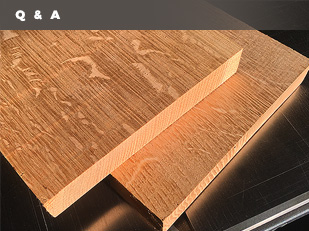
I have never applied a finish to this wood. And I am not a brush-on stain person; I am a tung oiler/Danish oiler person because they are so easy. My question is fairly specific: what is the general recommendation for the proper look/color as espoused by the Craftsman, Shaker, etc.? I have some water-based dark Mission brown on hand, for starters. I’m also guessing it might be the project where I learn to fill the grain. By the way, this project is just a small 10″x 8″, two-drawer box.
Michael Dresdner: It’s pretty difficult to get a filled-grain finish with wipe on coatings, and it is certainly not necessary for Mission, Craftsman, or Shaker styles. All used fairly thin, open grain finishes routinely. As for the proper color, that is a personal choice, but I’m guessing you want to know what color will make people respond ‘Oh, that’s Mission, isn’t it?’ The closest material I have found to that look is a colorant called asphaltum, and it is the primary ingredient in Minwax Jacobean color stain. It’s easy to use on oak, very available, and I’m guessing you’ll like it even more than what you would get if you went through the agony of fuming oak. By the way, if you really are committed to filling the pores, try Rockler’s Wunderfill. It is a fast drying water-based mixture sold as a putty that can be reduced with water to act like a pore filler. If you go the open pore route, try your finish on a sample first. Some wipe-on coatings, like Danish oils, tend to bleed back out of the pores of large pore woods like oak, leaving small hard nubs at the mouth of every grain line the next morning. If you want a wipe-on finish, try using either a jelled polyurethane (such as Bartley) or simply use any oil based polyurethane scrubbed on with Scotchbrite and wiped off while it is still wet. Use it uncut and you won’t have bleedback problems, or make it a bit slower, and perhaps easier to use, as a wipe-on by adding one ounce of boiled linseed oil per pint of polyurethane varnish.
Ellis Walentine: Both your questions beg the same answer. Finish according to your tastes. I never trust out-of-the-can stain colors with suggestive names, preferring to mix and experiment with colors until I have something I like. With white oak you could also try fuming the finished piece with blueprint ammonia (available at drafting supply stores), but be extremely careful not to get a whiff of the stuff. Fuming tones down all the oak colors to a deep, rich gray that turns brown under finish. You can then tone the color with any mixture of stains for a customized color and contrast before you apply the final finish. Regarding grain filling, the reason I’d fill the grain is because I wanted to hide the texture of the oak ? an unlikely event. But if you want a smooth, unbroken finish, fill the grain with tinted paste wood filler or pore filler after staining.





